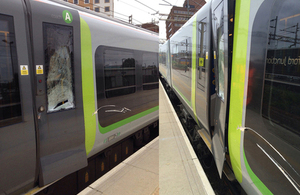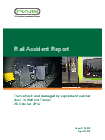Report 12/2015: Train struck and damaged by equipment cabinet door in Watford Tunnel
RAIB has released its report into an accident involving a train being struck and damaged by an equipment cabinet door in Watford Tunnel on 26 October 2014.

Images of damaged train courtesy of Network Rail
Summary
At around 07:19 hrs on Sunday 26 October 2014, the 06:42 hrs Milton Keynes Central to Euston passenger service struck the open door of a lineside equipment cabinet while travelling through Watford Tunnel. The cabinet door detached from its hinges, hitting the side of the train and damaging a door on the fourth carriage. The damage to the train door caused a safety circuit to detect that the door was no longer properly closed and the train’s brakes were applied automatically. Passengers in this carriage reported they had been showered by flying glass from the damaged door, but there were no injuries.
The RAIB’s investigation found that the cabinet door had opened under aerodynamic forces as the train passed, probably because the door had been left closed, but unsecured, during work that had been taking place on equipment in the cabinet overnight. A number of reasons why the door had been left unsecured were identified, including poor task lighting, no-one being allocated the responsibility for checking that cabinet doors were closed and secured and the possibility that the staff involved may have been suffering from fatigue. Siemens, the employer of the staff involved, had not fully implemented its policy on fatigue management.
The cabinet involved had been installed recently as part of a re-signalling project for the Watford area. Its doors had side hinges and had been positioned such that an open door could be struck by a train. The risk of this happening had not been identified when this design of cabinet was selected for use in Watford tunnel. Previous risk assessments undertaken during the period when the cabinet was originally subject to product acceptance were not available to the project team or Henry Williams Ltd, the manufacturer of the cabinet involved.
Recommendations
As a consequence of this investigation, RAIB has made six recommendations. Four recommendations have been made to Network Rail, covering processes for handing back sections of railway after engineering work, its policy on locating lineside equipment in areas of restricted clearance, the design of lineside equipment for areas of restricted clearance and improvements to its product acceptance processes so that previously undertaken risk assessments are available to future users of individual items of equipment. One recommendation has been made to Siemens UK Ltd in respect of its policies on staff welfare (including fatigue management), and one recommendation has been made to Henry Williams Ltd in conjunction with Network Rail to make sure that it has full details of the certification of its products used on the railways.
The RAIB has also identified two learning points. The first relates to the adequacy of task lighting and the need for staff on site to reach a clear understanding about who will be responsible for closing cabinet doors. The second is a reminder of the need for project staff to apply existing processes for risk assessment and product acceptance.
Notes to editors
-
The sole purpose of RAIB investigations is to prevent future accidents and incidents and improve railway safety. RAIB does not establish blame, liability or carry out prosecutions.
-
RAIB operates, as far as possible, in an open and transparent manner. While our investigations are completely independent of the railway industry, we do maintain close liaison with railway companies and if we discover matters that may affect the safety of the railway, we make sure that information about them is circulated to the right people as soon as possible, and certainly long before publication of our final report.
-
For media enquiries, please call 020 7944 3108.
